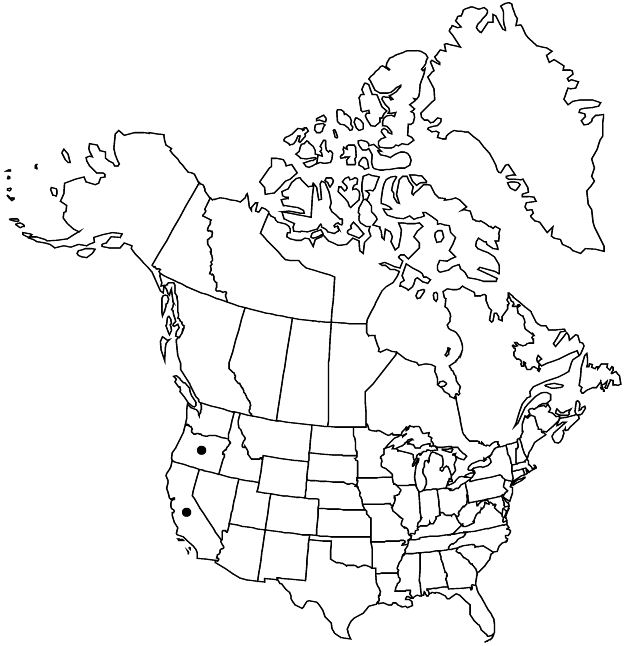Rosa bridgesii
Bull. Torrey Bot. Club 44: 83. 1917.
Subshrubs, forming open colonies. Stems erect, (1–)2–4(–8) dm, openly branched; bark often glaucous when young, gray to dark brown with age, glabrous; infrastipular prickles paired, erect, largest ± flattened, subulate, 3–10 × 2–7 mm, base glabrous, internodal rare or absent, smaller, mixed with aciculi, eglandular. Leaves 2.5–11 cm; stipules 5–10 × 2–4 mm, auricles flared, 1–3 mm, margins entire, usually sessile-glandular, surfaces glabrous, stipitate-glandular; petiole and rachis with sparse pricklets, glabrous or densely fine hairy hairs to 0.2 mm, densely stipitate-glandular; leaflets (3–)5–7, terminal: petiolule 3–20 mm, blade obovate or widely elliptic-cuneate to ± orbiculate, 10–30(–50) × 8–25(–30) mm, membranous to ± leathery, base rounded-obtuse, margins 2+-crenate, teeth 8–12 per side, obtuse, gland-tipped, apex obtuse to truncate, abaxial surfaces gray-green, finely puberulent, sometimes sparsely stipitate-glandular, adaxial green, dull, finely puberulent to glabrate. Inflorescences corymbs, 1 or 2(–7)-flowered. Pedicels erect, relatively slender, 5–17 mm, glabrous, eglandular or stipitate-glandular; bracts 1–3, lanceolate, 3–10 × 1–6 mm, margins entire, stipitate-glandular, surfaces glabrous, eglandular. Flowers 2.5–3.5 cm diam.; hypanthium ovoid-globose to widely urceolate, 4–5 × 3–4 mm, glabrous, rarely sparsely setose, usually eglandular, neck 0.5–1(–2) × 1.5–3 mm; sepals spreading, lanceolate, 6–14 × 2–3 mm, tip 0–4 × 0.5 mm, margins entire, abaxial surfaces puberulent, usually stipitate-glandular; petals single, deep pink, 10–20 × 10–20 mm; carpels 10–30, styles exsert 0.5–1 mm beyond stylar orifice (1–1.5 mm diam.) of hypanthial disc (2–4 mm diam.). Hips scarlet, ovoid to depressed-globose to pyriform, (8–)10–18 × 7–14 mm, fleshy, glabrous, rarely sparsely setose distally, eglandular, neck 1 × 2.5–4.5 mm; sepals persistent, erect. Achenes basiparietal, 1–11, cream to pale brown, 3.5–5(–6.5) × 2.5–4 mm. 2n = 14, 28.
Phenology: Flowering May–Aug.
Habitat: Open forest floors, meadow edges, rocky outcrops, midmontane forests, shade to sun
Elevation: 700–2500 m
Discussion
As here circumscribed, Rosa bridgesii is the Sierran-Cascade counterpart of R. spithamea, encompassing previous references to R. pinetorum and R. spithamea from the Sierra Nevada and most applications of R. yainacensis. The species is the low-growing, openly rhizomatous rose of midmontane forests in the Sierra Nevada and southern Cascade Range of California and Oregon. Finely puberulent leaflets help distinguish non-fruiting R. bridgesii from sympatric R. gymnocarpa, which has glabrous leaflets. Plants from Oregon differ from Sierran plants in that prickles are less likely to be infrastipular only.
In the phylogenetic analysis by A. Bruneau et al. (2007), Rosa bridgesii and R. spithamea comprise a distinct clade more closely related to Asian species than to others from western North America.
Rosa bridgesii has been conserved against R. calvaria Greene, R. covillei Greene, R. crenulata Greene, R. myriadenia Greene, and R. yainacensis Greene (B. Ertter 2007b). Only R. calvaria and R. crenulata are unambiguous synonyms of R. bridgesii; the taxonomic identity of the other names remains unresolved and may involve hybridization with other species.
On the basis of pollen size, E. W. Erlanson (1931) believed that material falling within the current circumscription of Rosa bridgesii was tetraploid (2n = 28). In a subsequent paper (1934), she reported a diploid somatic count (2n = 14) for R. calvaria, a synonym of R. bridgesii. Recent flow cytometry indicates a tetraploid condition for the sampled specimen of R. bridgesii (A. Bruneau et al., unpubl. data). It is possible that both ploidy levels are present within the species.
Selected References
None.

